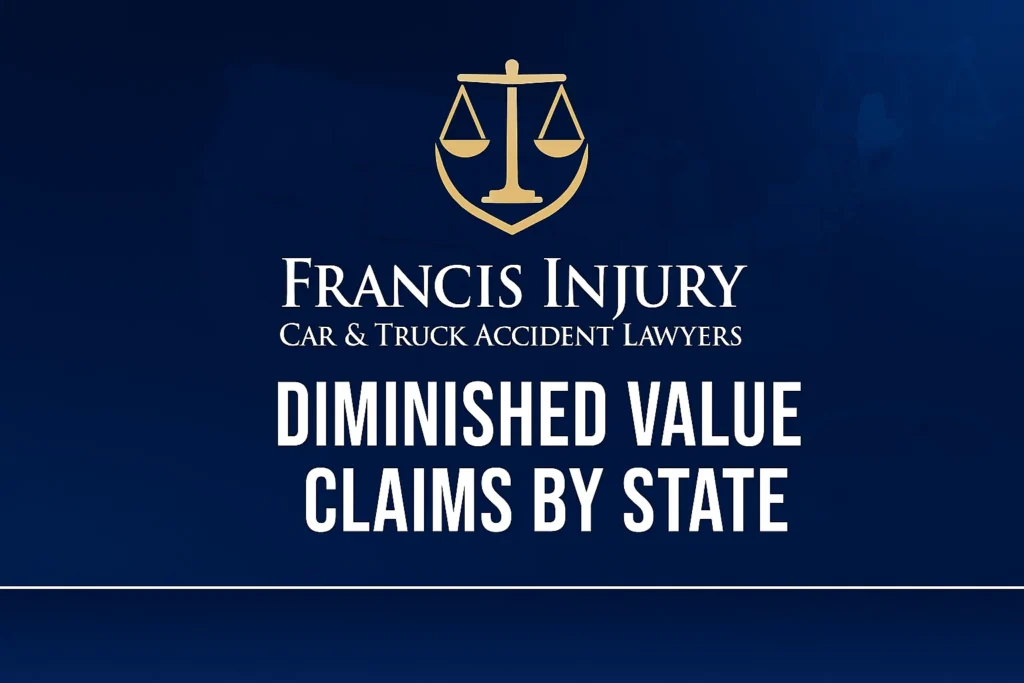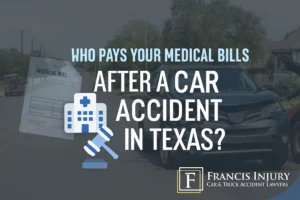Even after “perfect” repairs, an accident on your history can cut your car’s market price. This guide explains how diminished value (DV) works, what Texas drivers can claim, how timelines differ by state, and how to build a clean, persuasive claim file.

What is a Diminished Value claim?
Diminished value is the difference between your vehicle’s market value right before a crash and after it’s been repaired. Buyers (and dealers) discount cars with an accident on the record, which shows up in reports like CARFAX and directly affects price. Kelley Blue Book explains this simply, and it’s exactly what insurers evaluate when you ask to be made whole for the lost value.
Three types of diminished value
- Inherent DV: Loss purely from the accident history, even with excellent repairs.
- Repair-related DV: Loss caused by visible defects, poor workmanship, or non-OEM parts.
- Immediate DV: Loss between pre-crash value and value before any repairs (rare; timing-specific).
How diminished value works in Texas
Texas allows third-party DV claims against the at-fault driver’s insurer. If you were not at fault, your claim generally seeks the value loss that remains after proper repairs. Insurers often apply a version of the “17c” approach (a formula insurers use to estimate DV) as a starting point—feel free to push back with stronger evidence if their offer is light. For an overview of filing steps, see Bankrate’s step-by-step DV filing guide.
Who pays?
Typically, the at-fault driver’s liability insurer. If liability is disputed or coverage is limited, talk to a lawyer about strategy. (Texas drivers: keep an eye on the statute of limitations for property damage claims and act promptly.)
How to build a persuasive DV claim file
- Confirm fault & coverage. Get the other driver’s insurer info and claim number. If fault is disputed, note why you disagree.
- Document repairs. Keep body-shop invoices, parts lists (OEM vs aftermarket), and photos before, during, and after repairs.
- Establish market value. Pull pre- and post-repair valuations and comps. Start with KBB, then gather dealer trade-in quotes to corroborate.
- Order a professional appraisal. A USPAP-compliant DV appraisal often moves adjusters off low offers.
- Calculate your ask. Insurers may float a “17c” figure; counter with your comps, appraisal, and any repair-related defects.
- Negotiate in writing. Keep a tidy paper trail. If the delta is large, consider escalation or counsel.
In Texas, timing matters — let us push your claim forward
Francis Injury builds DV files that insurers take seriously. We’ll review your documents, line up the right valuation evidence, and negotiate for the strongest possible result.
Frequently Asked Questions
Possibly. “Inherent” DV exists even after quality repairs because the accident is on record. Dealers and buyers discount for that history.
It depends on pre-crash value, damage severity, mileage, age, model desirability, and visible repair issues. Start with valuations (e.g., KBB overview) and consider a professional appraisal.
Usually the at-fault driver’s insurer (third-party claim). First-party DV depends on your policy and state. See Bankrate’s filing guide for a quick checklist.
Deadlines vary by state (often 2–4 years; some longer). File as soon as repairs are complete so evidence is fresh. Michigan is different due to its mini-tort rules and a $3,000 cap—see Michigan DIFS.
A third-party DV claim is against the other driver’s insurer, so it generally doesn’t affect your premiums. First-party impacts depend on your policy and claim history.
Sometimes. Strong photo sets, repair invoices, and multiple local comps can work. But a USPAP-compliant appraisal often closes the gap on low offers.
State-by-State Snapshot (Quick Reference)
| State | First-Party DV | Third-Party DV | Source |
|---|---|---|---|
| Alabama | Usually No (policy-dependent) | Yes (prove loss) | MWL 50-State Survey |
| Alaska | Usually No | Yes | MWL 50-State Survey |
| Arizona | Usually No | Yes | MWL 50-State Survey |
| Arkansas | Usually No | Yes | MWL 50-State Survey |
| California | No for collision/comprehensive; UM/UIM depends on policy | Yes (standard property-damage measure) | CACI 3903J, Ray v. Farmers |
| Colorado | Usually No | Yes | MWL 50-State Survey |
| Connecticut | Usually No | Yes | MWL 50-State Survey |
| Delaware | No (repair/replace limits DV) | Yes | O’Brien v. Progressive (Del. 2001) |
| Florida | No (first-party); UM/UIM depends on policy | Yes | F.S. 626.9743, Siegle v. Progressive, FL CFO Consumer Page |
| Georgia | Yes (DV required) | Yes | State Farm v. Mabry (Ga. 2001) |
| Hawaii | Usually No | Yes | MWL 50-State Survey |
| Idaho | Usually No | Yes | MWL 50-State Survey |
| Illinois | Usually No | Yes | MWL 50-State Survey |
| Indiana | Usually No | Yes | MWL 50-State Survey |
| Iowa | Usually No | Yes | MWL 50-State Survey |
| Kansas | Usually No | Yes | MWL 50-State Survey |
| Kentucky | Usually No | Yes | MWL 50-State Survey |
| Louisiana | No (statute addresses 3P) | Yes (statute) | La. R.S. 9:2800.17 |
| Maine | Usually No | Yes (prove loss) | MWL 50-State Survey |
| Maryland | Collision/comprehensive: Usually No; UM/UMPD: Yes (must cover DV) | Yes | MIA Bulletin 24-8 (2024) |
| Massachusetts | Usually No | Yes | MWL 50-State Survey |
| Michigan | Usually No | Yes, but capped at $3,000 (mini-tort) | MCL 500.3135(3)(e) |
| Minnesota | Usually No | Yes | MWL 50-State Survey |
| Mississippi | Usually No | Yes | MWL 50-State Survey |
| Missouri | Usually No | Yes | MWL 50-State Survey |
| Montana | Usually No | Yes | MWL 50-State Survey |
| Nebraska | Usually No | Yes | MWL 50-State Survey |
| Nevada | Usually No | Yes | MWL 50-State Survey |
| New Hampshire | Usually No | Yes | MWL 50-State Survey |
| New Jersey | Usually No | Yes | MWL 50-State Survey |
| New Mexico | Usually No | Yes | MWL 50-State Survey |
| New York | Usually No | Yes | MWL 50-State Survey |
| North Carolina | Usually No (collision); UM/UMPD depends on policy | Yes; statutory appraisal available | G.S. 20-279.21(d1) |
| North Dakota | Usually No | Yes | MWL 50-State Survey |
| Ohio | Usually No | Yes (prove residual DV) | MWL 50-State Survey (see Ohio) |
| Oklahoma | Usually No | Yes | MWL 50-State Survey |
| Oregon | Usually No | Yes | MWL 50-State Survey |
| Pennsylvania | Usually No | Yes | MWL 50-State Survey |
| Rhode Island | Usually No | Yes | RI Claims Regs (DBR) |
| South Carolina | Usually No | Yes | MWL 50-State Survey |
| South Dakota | Usually No | Yes | MWL 50-State Survey |
| Tennessee | Optional DV coverage must be offered | Yes | HB 1737 (2022) |
| Texas | No (first-party), unless policy says otherwise | Yes | TDI Bulletin B-0027-00 |
| Utah | Usually No | Yes | MWL 50-State Survey |
| Vermont | Often Yes (absent exclusion; regulator guidance) | Yes | VT Bulletin 164 (quoted) |
| Virginia | Usually No | Yes (+post-repair residual DV) | MWL 50-State Survey |
| Washington | Depends (allowed unless excluded; many policies now exclude) | Yes | Moeller v. Farmers (Wash. 2011) |
| West Virginia | Usually No | Yes | MWL 50-State Survey |
| Wisconsin | Usually No | Yes | MWL 50-State Survey |
| Wyoming | Usually No | Yes | MWL 50-State Survey |
Why you can trust the “exception” calls
Georgia (first-party DV required): State Farm v. Mabry (Ga. 2001) held that first-party coverage includes diminution in value and imposed a duty to assess DV. NAIC
Florida (no first-party DV; third-party possible): Siegle v. Progressive confirms first-party DV isn’t owed when the policy repairs/replaces; Florida’s claims-settlement statute governs valuation practices for third-party claims. Florida Senate, FLDFS
Texas (no first-party DV by bulletin): TDI Bulletin B-0027-00 states first-party physical damage does not include DV (unless the policy says otherwise); third-party DV follows tort law. Matthiesen, Wickert & Lehrer S.C.
Washington (first-party DV allowed unless excluded): Moeller v. Farmers (Wash. 2011) recognized first-party DV under property coverage absent clear exclusion; many carriers later added exclusions.
Maryland (UM/UMPD must cover DV): MIA Bulletin 24-8 (Apr. 12, 2024) directs that mandatory UM/UIM property-damage coverage must include DV when proven; collision/comprehensive may still exclude by contract. Maryland Insurance Administration
Michigan (mini-tort cap): Michigan’s No-Fault law allows up to $3,000 for vehicle damage (including diminished value) in mini-tort actions for crashes after July 1, 2020. Michigan Legislature, Michigan.gov
Vermont (regulator guidance on DV): VT Insurance Bulletin 164 (8/10/2011) directs that DV must be considered and, absent contrary policy language, paid; widely cited in 50-state surveys. Matthiesen, Wickert & Lehrer S.C.
North Carolina (statutory appraisal for DV disputes): G.S. 20-279.21(d1) provides a mandatory appraisal pathway when the parties are far apart on DV.
Delaware (no first-party DV): O’Brien v. Progressive (Del. 2001) held repair/replace language does not include diminished value.
Method note: For states without a unique statute/case in the table, I used the most recent Matthiesen, Wickert & Lehrer S.C. 50-state DV compendium as the baseline and spot-checked outliers against primary sources.
Contact Francis Injury
Phone: 817-329-9001 | Free Consultation: Contact Us
Fort Worth Office
640 Taylor St, Suite 1200B, Fort Worth, TX 76102





